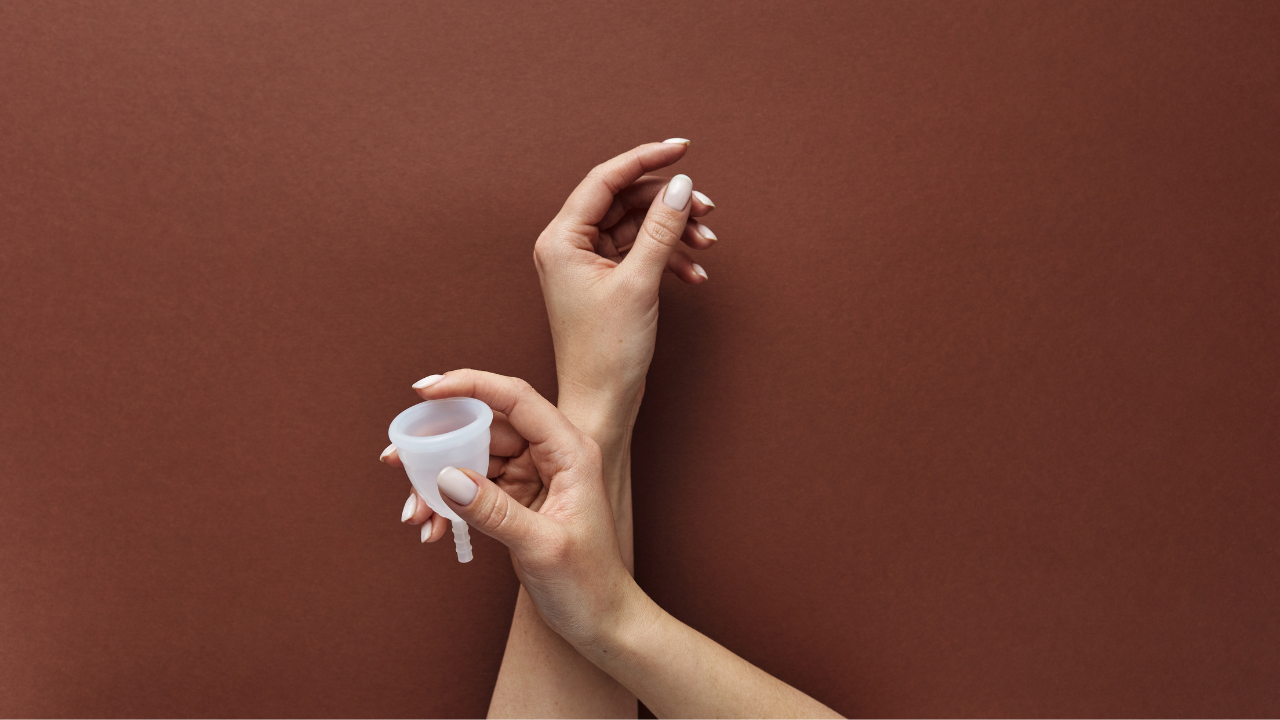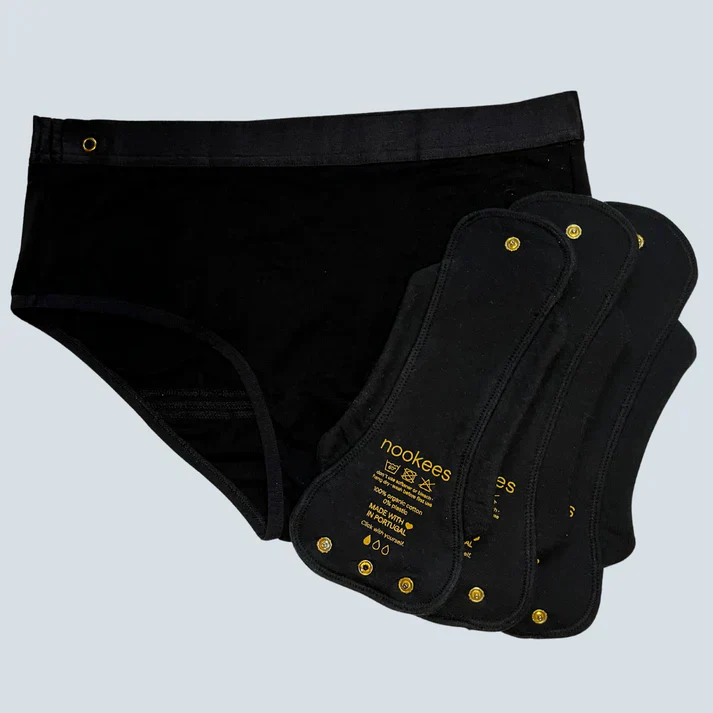
Tampon Alternatives You Can Reuse Safely for Years
Table of Contents
Tampon alternatives are products designed to manage menstruation without relying on cotton plugs. Some are disposable, but many are reusable, where instead of throwing them away after a few hours, you wash them and wear them again, which means a single product can last years.
Tampons can leave the vagina feeling uncomfortably dry on light flow days, and because they sit inside the canal absorbing everything, they sometimes disrupt the body’s natural balance.
Many brands also contain chemical additives from bleaching and processing, something most of us would rather not place inside such a sensitive part of the body. Tampons are also an endless monthly purchase, while one cup or a period blanket can replace thousands of disposables over their lifespan.
5 Menstrual Products That Work as Well as Tampons
Medical Grade Menstrual/ Period Cups

A menstrual cup is a flexible device ususally made of medical-grade silicone that sits inside the vagina and collects menstrual fluid. Unlike tampons, it doesn’t absorb, which means it leaves the vaginal canal naturally lubricated and reduces irritation. With proper care, one cup can last between five and ten years, making it a long-term, cost-effective choice. Because cups don’t carry the same risks associated with fibers sitting in the vaginal canal, the risk of toxic shock syndrome is considered lower compared to tampons.
The cup sits just beneath the cervix. When inserted, it unfolds and forms a light seal with the vaginal walls, so that blood flows directly from the cervix into the cup’s reservoir. The base of the cup rests just behind the pubic bone, while the stem sits lower down, acting as a guide for removal. This placement explains why a menstrual cup can hold much more than a tampon, usually between 20 and 40 milliliters compared to 5 to 18 milliliters. On heavy days, this difference means a woman may only need to empty her cup twice daily, whereas she might go through several tampons in the same time.
Most cups can be worn for eight to twelve hours, which makes them practical for long workdays or overnight use. Removing the cup requires pinching the base to release the seal and gently guiding it down and out, which can take a few cycles to master. Cleaning is simple but requires access to water, so public bathrooms can be less convenient. At home, rinsing with clean water is usually enough between uses, and at the end of each cycle, boiling the cup for a few minutes keeps it fully sanitized.
Menstrual/Period Blankets

A menstrual blanket is a reusable surface protector that you can bleed onto directly. Unlike cups, discs, pads, or period underwear, it isn’t worn inside or against the body. Instead, it’s spread over a bed, couch, or any place you want to, creating a soft, washable barrier that absorbs period blood without interrupting comfort. Most period blankets, like the Free Bleed® Blanket are made with a plush fabric layer on top and a hidden waterproof lining inside, so they look and feel like a regular blanket while preventing leaks from soaking through.
The biggest advantage of a menstrual blanket is its capacity. Tampons, cups, and underwear all have absorbency limits that require frequent changes, but a blanket can handle gushes, heavy overnight bleeding, postpartum flow, or free bleeding throughout the day. Many women also use them during period sex, since they keep sheets and mattresses protected while allowing freedom to move without interruption.
Because these blankets are washable and designed to last for years, they are both eco-friendly and cost-effective. They eliminate the cycle of throwing away stained sheets or buying disposable mattress protectors. The main drawback is that they are not wearable. For best hygiene and to prevent stains, you’ll want to rinse or wash it within a day of bleeding onto it. Blood that dries into the fibers for longer than 24 hours can become harder to wash out completely and may leave discoloration.
For women who want freedom and security without inserting or wearing a product, a menstrual blanket offers something no other period product can.
Period Underwear

Period underwear looks and feels like regular underwear but is built with discreet layers that absorb menstrual fluid and prevent leaks. You simply wear them like everyday panties. With proper care, a single pair can last several years, making them a sustainable and reliable choice for many cycles.
The protection comes from multiple fabric layers working together. The innermost layer sits against the skin and wicks fluid away quickly so you don’t feel damp. Beneath that is a highly absorbent core that locks in blood, and different styles hold anything from the equivalent of one tampon’s worth to five. The final layer is waterproof yet breathable, preventing leaks from reaching clothing or bedding while still allowing airflow so you don’t feel sweaty.
Most pairs can be worn for 4 to 12 hours depending on absorbency. For lighter days or spotting, they can be worn on their own; for heavier flows, many women pair them with a cup or disc for extra protection. After use, they must be rinsed, washed, and dried before re-wearing, which is the main inconvenience compared to disposables. The higher upfront cost is another factor, though the long lifespan offsets years of buying pads or tampons.
Reusable Cloth Pads

Reusable cloth pads work much like disposable pads, but instead of adhesive strips and plastic backing, they’re made of soft, breathable fabrics that snap or clip around the underwear. They come in different lengths and absorbency levels so you can match them to your flow. Most last between two and five years, making them a long-term alternative that saves both money and waste.
Cloth pads avoid the synthetic fibers and plastics used in many disposables, which can irritate sensitive skin. Because they’re breathable, they also feel less sweaty during warm weather. For women trying to cut down on landfill waste, cloth pads are a straightforward way to eliminate hundreds of single-use pads each year.
Protection typically lasts four to six hours, depending on your flow. The only drawback is that they need to be washed after every use, and if the snaps aren’t secure, they can shift around during movement. However, with proper care, they’re durable enough to last years.
Menstrual Discs
Menstrual discs are flexible, bowl-shaped devices that sit high inside the vaginal canal, just beneath the cervix. Unlike cups, which rest lower and form a seal against the vaginal walls, a disc tucks behind the pubic bone and stays in place through anatomical support rather than suction. This placement allows it to sit almost unnoticed and to collect fluid directly as it leaves the cervix. Because of its wide, shallow shape, a disc can hold more than most cups, up to 70 milliliters, which is two to three times the capacity of a super tampon.
One of the biggest advantages of menstrual discs is their unique ability to be worn during penetrative sex. Since they sit higher and flatter than cups, they don’t interfere with vaginal penetration, offering mess-free intimacy even during menstruation. They also provide long wear time, often eight to twelve hours, which makes them practical for busy days or overnight protection.
There are some challenges with discs. Insertion and removal take practice, and the process can be messier than with cups since some discs have no stem and must be hooked out with a finger. Some discs are designed as disposables, which creates plastic waste, though reusable versions are available and preferred for sustainability.
Frequently Asked Questions
Yes, tampon alternatives can be just as effective, and in many cases, they provide longer protection and hold more blood. For example, menstrual cups and menstrual discs can collect menstrual fluid directly from the cervix and hold up to three times the absorbency level of traditional tampons. Period underwear and reusable pads are increasingly popular because they feel like regular underwear or cloth pads yet prevent leaks for hours at a time.
The best alternative period product depends on your body and flow. Menstrual cups, made of medical grade silicone, are a reusable option that lasts for years and saves money in the long run. Menstrual discs offer very high capacity and even allow penetrative sex during menstruation. Reusable cloth pads and period underwear are excellent for those who want something external, comfortable, and easy to wash. For lighter days, period panties feel like normal underwear while still managing period blood. Even sea sponges, sometimes called sponge tampons, have been used as an alternative, though they come with specific care instructions.
Many ob-gyns recommend body safe, medical grade products that respect the vagina’s natural environment. Menstrual cups and discs do not dry out the vaginal canal or disrupt vaginal pH the same way traditional tampons can, and they significantly reduce the risk of toxic shock syndrome compared to tampon use. Reusable cloth pads and menstrual underwear also avoid chemical additives and plastics, offering breathable, skin-friendly protection. Choosing an alternative menstrual product also benefits the reproductive system by reducing exposure to harmful chemicals while supporting eco friendly and cost effective menstrual care.
Before modern feminine hygiene products, Native American women relied on natural materials that worked in the same way as tampons but came from the land. Historical records show that some tribes used soft moss, plant fibers, and even animal pelts as absorbent materials to manage menstruation. These traditional period products functioned as early forms of sponge tampons or cloth pads, disposable in form but fully able to decompose back into the earth.

